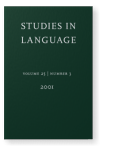Vol. 25:3 (2001) ► pp.405–422
The rise and fall of a rogue relative construction
In the earliest attested stage of the Akkadian language, relative clauses were introduced by a pronoun which agreed in case with the head noun in the main clause, rather than with the relativized NP in the relative clause. Such a system is extremely rare across languages, is demonstrably dysfunctional, and has been termed ‘inherently disfavoured’. This article attempts to explain how Akkadian acquired this rogue relative construction, and how the language then managed to get rid of it. I argue that this construction was only an unstable way-station in the emergence of a new relative clause in the language. The final section of the article examines the few parallels from other languages to the Old Akkadian system.
Cited by
Cited by 4 other publications
This list is based on CrossRef data as of 14 april 2024. Please note that it may not be complete. Sources presented here have been supplied by the respective publishers. Any errors therein should be reported to them.
